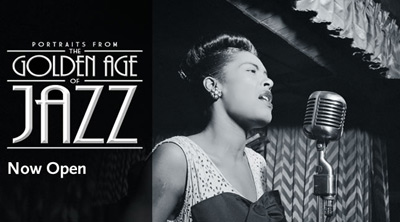Celebrating the Musical Instrument Museum’s
Newly Expanded Jazz History Exhibit
By Patricia Myers

If you haven’t been to Arizona’s Musical Instrument Museum yet, put it at the top of your New Year’s Resolutions. The captivating MIM continues to receive acclaim for its exhibits, programs and concert series, and they rounded out 2012 with a month long star-studded concert series called “All That Jazz,” staged to introduce the MIM’s newly expanded jazz history exhibit. The series included the Branford Marsalis Quartet, Manhattan Transfer, DIVA Jazz Trio with saxophonist Grace Kelly, and a Django Reinhardt Tribute. All That Jazz month also included the opening of a touring exhibition, "Portraits from the Golden Age of Jazz: Photographs by William Gottlieb" on display through April 6, 2013. The MIM is showcasing instruments and video footage of many of the featured musicians alongside 71 photographs of jazz legends.
The museum's Artist Gallery includes George Benson's Gibson Johnny Smith model guitar and one of his many Grammy Awards; Carlos Santana's custom Yamaha guitar with inlaid Buddhist motifs; an early Paul Reed Smith (PRS) guitar played by Santana, a precursor to the "Supernatural" guitar, named after his multiple Grammy-winning album; the Steinway piano on which John Lennon composed "Imagine," and the first Steinway piano, built in the 1836 kitchen of Henrich Engelhard Steinweg's home in Seesen, Germany. The Experience Gallery features instruments that can be touched and played.
The Musical Instrument Museum opened in April 2010 with collections representing five global regions. The original small American jazz component was expanded in 2012 into one of the museum's larger genre exhibits, with three sections of 66 instruments, 31 video clips and 23 images that represent jazz from its early days through swing, bebop, cool, hard bop and contemporary forms. All That Jazz month was launched with the All That Jazz weekend featuring concerts, curatorial talks, presentations by guests from the Smithsonian Institution and the Ella Fitzgerald Charitable Foundation, and live music by local jazz groups. Segments in the newly expanded exhibit are Early Jazz, Women in Jazz and Latin Jazz. The Early Jazz Exhibit includes Phoenix-born drummer Lewis Nash and Arizona resident Joey DeFrancesco.
Local legend Nadine Jansen is featured in the Women in Jazz segment. Her flugelhorn is on view, along with a video of her recording with Marian McPartland for a 1988 Piano Jazz radio program that shows this amazing musician playing trumpet with right hand and piano with left at the same time (she also sang). Both Wynton Marsalis and his father, Ellis, sat in with Nadine at J. Chew & Co. after their own concerts elsewhere.  A posthumously issued CD, “The Very Best of Nadine Jansen,” offers 16 songs chronologically assembled from reel-to-reel tapes, cassettes and previous albums (1949-89), co-produced by John Dixon, Jack Miller and Patricia Myers.
A posthumously issued CD, “The Very Best of Nadine Jansen,” offers 16 songs chronologically assembled from reel-to-reel tapes, cassettes and previous albums (1949-89), co-produced by John Dixon, Jack Miller and Patricia Myers.
The MIM, a Smithsonian affiliate, expanded its permanent jazz collection by borrowing several instruments from the Smithsonian's National Museum of American History for display, including clarinets played by Benny Goodman and Artie Shaw, and a trombone played by J.J. Johnson. Other pieces include a trumpet mouthpiece and mute used by Miles Davis and a guitar played by Charlie Christian. A cornet associated with Louis Armstrong is part of the Early Jazz segment, a beaded gown and lyric sheets owned by Ella Fitzgerald is in the Women in Jazz exhibit, and a saxophone played by Mario Bauzá and timbales are on loan to MIM from Eddie Palmieri for the Latin Jazz exhibit.
The concerts were staged in the music theater of the 200,000-square-foot building, which has two floors of galleries displaying a collection of nearly 15,000 instruments and associated objects. The MIM offers both docent-led and self-guided tours using wireless audio guides that interface with the sound track for videos at more than 300 sites in 80,000 square feet. Hidden identifiers are installed at exhibits that cue the audio guides automatically to exactly the right sound track as the viewer approaches each video screen. Built at a cost of $250 million, MIM also features a recording studio, classroom, café, coffee shop, courtyard and gift shop.
To find out all the MIM has to offer, check out their website at MIM.org
Let us know how you think we're doing. Drop us a note at Editor@MusicAndMoreAZ.com.